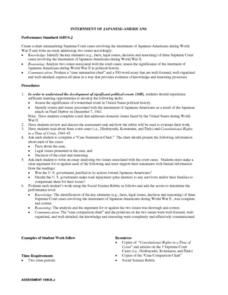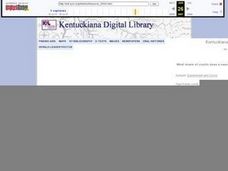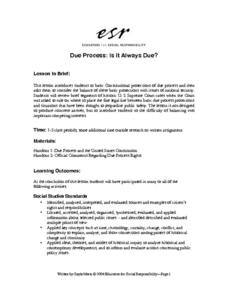Judicial Learning Center
The Constitution
Supreme Court justices debate the meaning of the US Constitution, but we expect teachers to explain it to scholars with far less training and experience. A daunting task for sure, but it's not insurmountable with resources that simplify...
Judicial Learning Center
The U.S. Supreme Court
How do Supreme Court justices determine which cases to consider? What happens when the Supreme Court decides not to take a case? The lesson explores important questions and others in the field of criminology. It focuses on the appeals...
Judicial Learning Center
Law and the Rule of Law
We hear a lot about the importance of the rule of law, but most people do not really know what those words mean. The lesson is a webpage that defines the rule of law, explains why it is important in a democratic society and provides...
Curated OER
Ohio Statehouse History
Fourth graders examine the history of the Ohio Statehouse and order the major historical events in its development. The instructional activity traces the development from the time of Ohio's vast wilderness to the house's completion in 1861.
Curated OER
The "Big Four"
Students identify the four individuals who are identified as the "Big Four", examine the years they were on the bench together, and look and the impact they made in key cases.
Curated OER
Stories of Freedom and Justice: Learning Resources
Students are introduce to the topic of nonviolence and civil rights by watching a video. For this stories of freedom lesson, students examine the Supreme Court's role in interpreting the U.S. Constitution. Students analyze how conflict...
Curated OER
What is a Court?
Students examine and discuss the judicial branch of the U.S. government. They define what a court is, list three characteristics of a trial court and an appellate court, and analyze various trial and appeal situations.
Curated OER
Internment of Japanese-Americans
Students assess the significance of a watershed event in the political history of the United States . They identify events and issues associated with the internment of Japanese-Americans as a result of the Japanese attack on Pearl Harbor...
Curated OER
The Bill of Rights and the Supreme Court
Learners explore what the United States would be like today if the Bill of Rights had never been written. In this exploring the constitution lesson, students research Supreme Court cases that were heard in the early years of the U.S....
Curated OER
iCivics: Executive Command
Students explore the role of President of the United States. In this executive branch lesson plan, students play an online game that requires them to consider the needs of Americans as they act as president.
Curated OER
Separation of Powers
Eighth graders explore and explain the responsibilities and limits of our national system of government. After reading various selections documenting the viewpoints of the federalists and anti-federalists and the separation of power,...
Curated OER
Federal Court Systems and Court Cases
Ninth graders investigate the basis for the Common Law Tradition. They examine the organization of the Federal Court System and students identify the various sources of the American Law.
Curated OER
Constitution
Ninth graders simulate a U.S. Supreme Court hearing concerning a First Amendment case about school prayer by participating in a hearing.
Curated OER
Successful Deaf Leaders in Government
Students research branches and agencies of state government to further explain how legislation and initiatives impact Deaf community. They conduct email interviews with Deaf government leaders, and create electronic portfolios.
Curated OER
Due Process: Is It Always Due?
Students explore the basic Constitutional protections of due process and then consider the balance of these basic protections with issues of national security. A variety of segments of U.S. Supreme Court cases are examined in this...
Curated OER
The Supreme Court
Students examine the Fourteenth Amendment. In this Supreme Court lesson, students define due process and equal protection as they analyze the impact of the amendment and the Supreme Court on workers' rights in the early 20th century....
Curated OER
Just how broken is the Senate?
Twelfth graders examine the role of the Senate in the United States. In this American Government lesson plan, 12th graders read various articles and answer questions to these articles. Students write a letter to their Senator on a...
School Improvement in Maryland
Dividing the Powers of Government
Who does what? To develop an understanding of the balance of power between the US federal and state governments, class members research responsibilities in terms of legal systems, security issues, economic activities, lawmaking, and...
Curated OER
Organization of Fairfax County Government
Middle schoolers identify Fairfax County government as council-manager government, describe term of office held by members of Board of Supervisors and districts they represent, how Chairman of Board of Supervisors is elected and term and...
Curated OER
Making an Appeal
Students make an appeal. In this making an appeal lesson plan students give characteristics of the Washington Supreme Court. Students examine public policy conflicts and present an appellate case.
Curated OER
dsfa
Students work in groups examining the school's policy of no weapons on school property.
Curated OER
Faces of the Bench
Learners use primary source documents to gather information on justices in the Michigan Supreme Court. They write about the thoughts and experiences of the author. They identify and describe each justice briefly.
Curated OER
The "Big Four" of the Michigan Supreme Court
Learners identify the justices on the Michigan Supreme Court known as the "Big Four". They relate to them by researching their lives. They participate in an activity in which they practice their investigation and presentation skills.

























